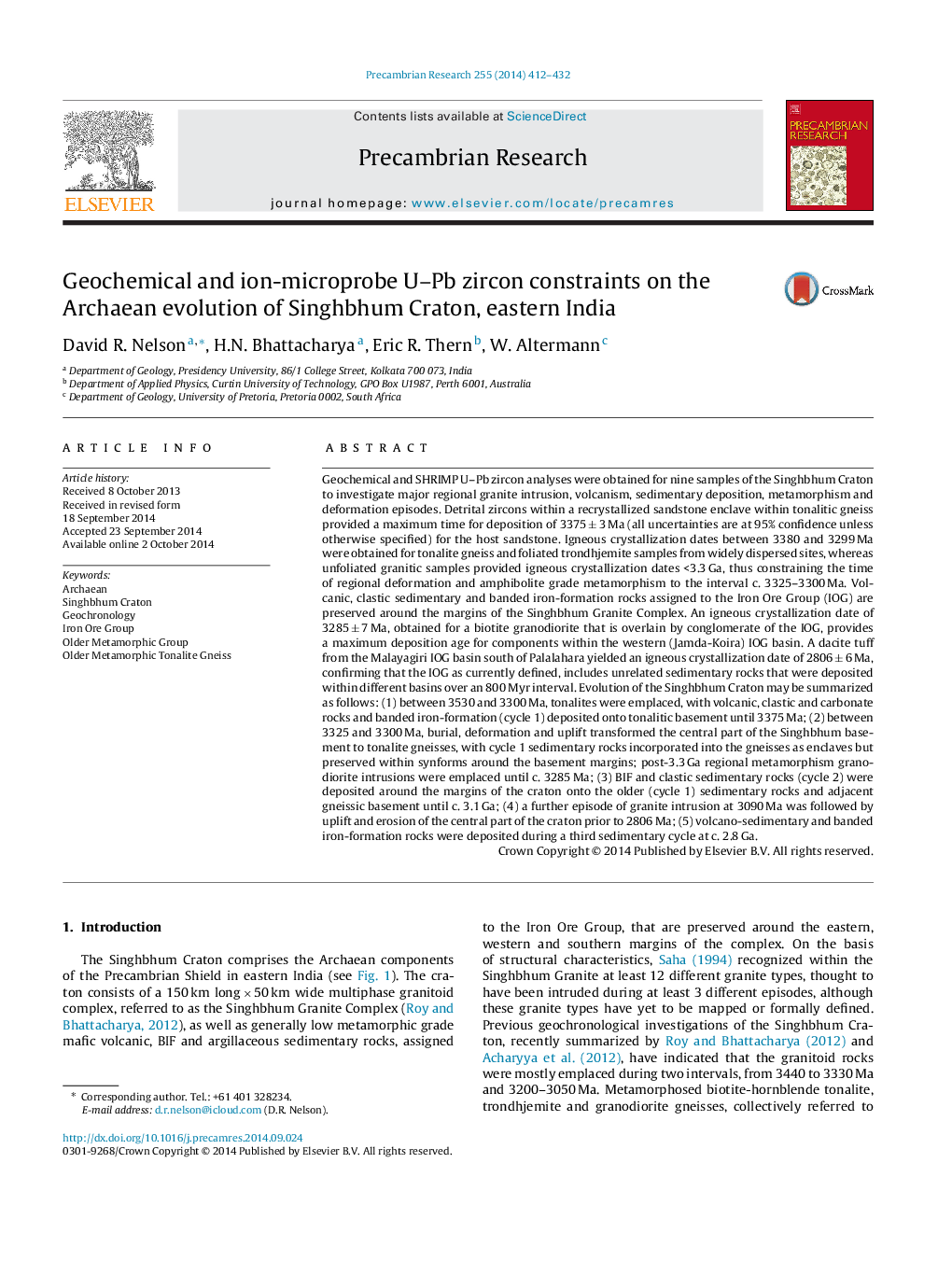| کد مقاله | کد نشریه | سال انتشار | مقاله انگلیسی | نسخه تمام متن |
|---|---|---|---|---|
| 4722797 | 1355488 | 2014 | 21 صفحه PDF | دانلود رایگان |

• Geochemical and SHRIMP U–Pb analyses were obtained for 9 Singhbhum Craton samples.
• Archaean magmatic, sedimentary, metamorphic and deformation episodes were resolved.
• Singhbhum tonalites were emplaced and BIF deposited between 3530 and 3300 Ma.
• Burial and deformation at 3325–3300 Ma transformed Singhbhum basement to gneiss.
• As currently defined, IOG includes unrelated sediments deposited over 800 Ma.
Geochemical and SHRIMP U–Pb zircon analyses were obtained for nine samples of the Singhbhum Craton to investigate major regional granite intrusion, volcanism, sedimentary deposition, metamorphism and deformation episodes. Detrital zircons within a recrystallized sandstone enclave within tonalitic gneiss provided a maximum time for deposition of 3375 ± 3 Ma (all uncertainties are at 95% confidence unless otherwise specified) for the host sandstone. Igneous crystallization dates between 3380 and 3299 Ma were obtained for tonalite gneiss and foliated trondhjemite samples from widely dispersed sites, whereas unfoliated granitic samples provided igneous crystallization dates <3.3 Ga, thus constraining the time of regional deformation and amphibolite grade metamorphism to the interval c. 3325–3300 Ma. Volcanic, clastic sedimentary and banded iron-formation rocks assigned to the Iron Ore Group (IOG) are preserved around the margins of the Singhbhum Granite Complex. An igneous crystallization date of 3285 ± 7 Ma, obtained for a biotite granodiorite that is overlain by conglomerate of the IOG, provides a maximum deposition age for components within the western (Jamda-Koira) IOG basin. A dacite tuff from the Malayagiri IOG basin south of Palalahara yielded an igneous crystallization date of 2806 ± 6 Ma, confirming that the IOG as currently defined, includes unrelated sedimentary rocks that were deposited within different basins over an 800 Myr interval. Evolution of the Singhbhum Craton may be summarized as follows: (1) between 3530 and 3300 Ma, tonalites were emplaced, with volcanic, clastic and carbonate rocks and banded iron-formation (cycle 1) deposited onto tonalitic basement until 3375 Ma; (2) between 3325 and 3300 Ma, burial, deformation and uplift transformed the central part of the Singhbhum basement to tonalite gneisses, with cycle 1 sedimentary rocks incorporated into the gneisses as enclaves but preserved within synforms around the basement margins; post-3.3 Ga regional metamorphism granodiorite intrusions were emplaced until c. 3285 Ma; (3) BIF and clastic sedimentary rocks (cycle 2) were deposited around the margins of the craton onto the older (cycle 1) sedimentary rocks and adjacent gneissic basement until c. 3.1 Ga; (4) a further episode of granite intrusion at 3090 Ma was followed by uplift and erosion of the central part of the craton prior to 2806 Ma; (5) volcano-sedimentary and banded iron-formation rocks were deposited during a third sedimentary cycle at c. 2.8 Ga.
Journal: Precambrian Research - Volume 255, Part 1, December 2014, Pages 412–432